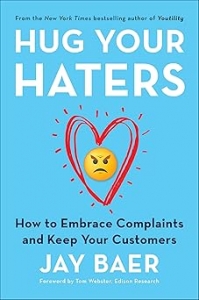Hater-Hugging Content Marketing
When customers complain, the last thing you feel like doing is giving them a hug. But that’s precisely what Jay Baer recommends in his book Hug Your Haters. In fact, Baer teaches, openly embracing and dealing with complaints can turn bad news into very good news for your business, because complaints can help you:
- create advocacy
- gather insights
- differentiate you from your competitors
When Baer talks about dealing with complaints, he means all complaints, all clues that a customer’s experience with a business or practice hasn’t been up to expectations. That means paying attention to in-person and phone conversations. Most “haters”, though, complain “offstage”, rather than directly confronting an owner or customer service rep via phone or in persona, they use e-mail , texts, and post negative reviews, Baer explains in a podcast hosted by Kerry O’Shea Gorgone.
An Inc. Magazine review of the book emphasized a startling observation by Baer – Complainers fall into two camps – those seeking help and those merely seeking attention. The first category of complainers actually want and expect a response; while the complainers don’t expect a response, when they do receive one, they are twice as likely to recommend that company in the future.
Too many business owners shy away from regular posting of articles and blogs for fear of receiving negative comments, we’ve found at Say It For You. Of course, if you don’t create and publish content frequently, you may not receive as many negative reactions, but neither will you attract the attention of search engines or of readers! In fact, “getting in front” of complaints by demonstrating in your content how you remedied a negative customer situation is probably the most positive kind of publicity you can ask for! Don’t be afraid of showing your err-is-human side. Your blog, I emphasize, gives you a chance to turn a “failure” into a success story.
However, unlike working to amass “piles” of compliments in the form of reviews and survey responses, look for opportunities to create content telling “the whole story” – what the issue, problem, or complaint was, how you worked to solve it, and why the solution worked better than what the customer had ever experienced before.


Leave a Reply
Want to join the discussion?Feel free to contribute!